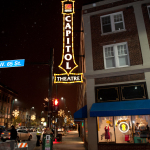
James Brooks
Arts Strategies from Cleveland and Dayton
Posted by Feb 05, 2015 0 comments

James Brooks

The Gordon Square Arts District (GSAD), which is located in Cleveland’s Westside neighborhood, has four major goals – to improve the district’s streetscapes, to create additional parking throughout the district, to restore and renovate the Cleveland Public Theatre and the Capitol Theatre, and to build a permanent home for the Near West Theatre inside the district.
 Capitol Theatre, Opening Night
Capitol Theatre, Opening NightThe main partners in GSAD are the Cleveland Public Theatre, the Near West Theatre, and the Detroit Shoreway Community Development Organization - which owns the Capitol Theatre. These non-profits and business owners have worked in collaboration for over a decade to develop and implement improvements to their neighborhood. What began as an artistic makeover has grown into a thriving business and economic venture between the partners, the surrounding neighborhood, and the city of Cleveland. In addition, the three partners have formed relationships with many different funding organizations and sponsors and continuously praise their mutual efforts through various media outlets.
 The Gordon Square Arts District is funded through a combination of over 1,000 public, private, and philanthropic grants, funds, and contributions. Examples of funders include the City of Cleveland, Federal and State Historic Preservation Tax Credits, Community Development Block Grants, The Cleveland Foundation, The Kresge Foundation, and the Majic Family Fund. The GSAD began its fundraising efforts in the 1990s in order to develop an initial master plan and economic feasibility study. The overall fundraising goal of $30 million to complete the revitalization efforts was reached in 2014.
The Gordon Square Arts District is funded through a combination of over 1,000 public, private, and philanthropic grants, funds, and contributions. Examples of funders include the City of Cleveland, Federal and State Historic Preservation Tax Credits, Community Development Block Grants, The Cleveland Foundation, The Kresge Foundation, and the Majic Family Fund. The GSAD began its fundraising efforts in the 1990s in order to develop an initial master plan and economic feasibility study. The overall fundraising goal of $30 million to complete the revitalization efforts was reached in 2014.
 By the end of 2013, GSAD had completed streetscape improvements (including new plantings, landscaping, underlit benches, way-finding signage, removal of utility lines, widened sidewalks, and decorative street lamps), added three additional parking lots, and completed renovations to the Capital Theatre. Renovations are underway at the Cleveland Public Theatre and the opening of the new Near West Theatre is anticipated for early 2015.
By the end of 2013, GSAD had completed streetscape improvements (including new plantings, landscaping, underlit benches, way-finding signage, removal of utility lines, widened sidewalks, and decorative street lamps), added three additional parking lots, and completed renovations to the Capital Theatre. Renovations are underway at the Cleveland Public Theatre and the opening of the new Near West Theatre is anticipated for early 2015.
From 2006-2014 the Westside neighborhood alone acquired over 75 new businesses, 520 new jobs, and is expected to gain nearly $500 million in economic development funds.
Dayton
The Schuster Performing Arts Center is the home of the Dayton Philharmonic as well as the city’s opera and ballet companies. Although the Center itself only dates to 2003, the performing artists have been at the heart of the city’s cultural life for considerably longer.
Individually, these performers were contributing much to the Dayton cultural life. The Philharmonic, for example, had long been known for its music education programs. The economic contraction of the Great Recession and the outdated operational models of so many performing arts nonprofits began to threaten the very existence of these institutions, including Philharmonic. In July 2011, with considerable leadership provided by music director Neal Gittleman and the Dayton Foundation, the decision was made to merge the ballet, opera, and philharmonic into a single nonprofit performing arts alliance for the city of Dayton and the surrounding region.
Three years after the fact, the merger has proven a success. The highly coordinated performance schedule at the Schuster now ensures maximum use of the space. Partnerships between the ballet and the philharmonic ensure first class orchestral accompaniment for performances. Back office functions too are consolidated delivering efficiencies in payroll, purchasing, promotions, and program development. Patrons can even make use of their event tickets to ride the public transit system that serves the center.
For the future, the prospect is for steady growth. Programs have been launched to bring new audiences to the performing arts. The “community nights” program targets neighborhoods in Dayton and surrounding municipalities to come to the Schuster on reduced price tickets. During January, the Welcome to Dayton Weekend series offered free performances to introduce classical performances to residents and especially to new immigrants. The ENCORE! Program is built for young professionals looking to mix networking with the performing arts. The build-you-own subscription series allows patrons to select ballet, opera, and symphony performances on a mix and match basis. The Stained Glass Series comprises three concert dates that are free and open to the public and that combine the Dayton Philharmonic with the choirs from churches across the city.
These examples from Cleveland and Dayton of local solutions for the unique needs of a community demonstrate the significant value that city leaders and residents place on keeping and expanding arts programs, and how great results can be achieved through partnerships.
